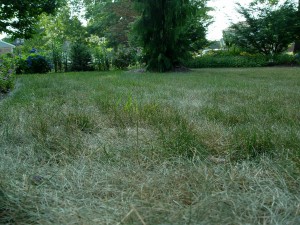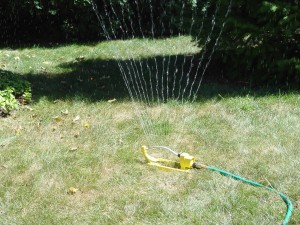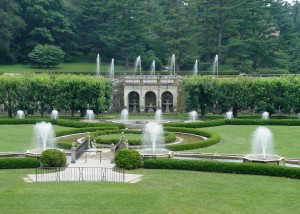Water and Grass
August 2nd, 2011
Yeah, that lush, green carpet of a lawn might look pretty good.
But when the temperatures park themselves in the 90s day after day and rain shuts off, it’s time to back off of that expectation for awhile.
Grass is smart enough to go dormant in a heat wave.
By shutting down growth and going brown, grass is able to conserve enough moisture in the crowns (where grass grows from) that it can go 6 weeks in parched conditions.
Then when rain returns, it greens back up again, and everyone’s happy.
When nature’s game plan goes awry is when some folks decide they want those verdant springtime conditions even when the weather is no longer cooperating.
It takes a whole lot of precious water to keep a lawn green in a bake-oven of a summer. That’s not only expensive but wasteful and counter-productive in at least three ways.
How?
1.) If you water often but too lightly, you encourage grass roots to stay high up in the soil surface, where grass becomes less drought-resistant, more at risk from heat injury and more likely to develop a thatch problem (that spongy layer mostly of dead roots between the growing grass and the soil).
2.) Beetle grubs proliferate best when the soil is moist when the eggs hatch these next few weeks. One of the few advantages of hot, dry turf is that it’s not good for grub hatch. In other words, grubs will thank you for irrigating that lawn.
3.) Shallow-rooted grass that’s kept consistently damp at the surface and on the grass blades is more prone to disease and bug attack.
If you’re dead set on watering the lawn, Penn State’s Turfgrass Center recommends at least waiting until you see the first signs of the grass wilting.
Then put on enough to dampen the entire root zone — not just the top inch or so. The majority of grass roots go down 6 inches, so aim to add enough water to reach that depth.
How much and how long that’ll take will depend on the composition of your soil and the rate at which you’re applying water.
The exception is a new lawn.
Grass you’ve seeded this spring or even last fall is still rooting. Young grass benefits from keeping the soil consistently damp at and near the surface.
One other exception is grass under extreme stress. As we saw last summer, some grass crosses the line from dormant to dead when temperatures push 100 degrees.
Some of our northern-climate “cool-season grasses” (perennial ryegrass, Kentucky bluegrass and fine fescue) call it quits when our summer seems more like Dallas.
Usually it’s patches suffering from some other setback as well, such as compacted soil, excess soil salt, grass that’s scalped and proximity to asphalt roads or hot driveways.
Grass is pretty good about taking one or two strikes, but three strikes and it’s out.
The ideal solution is to correct the setbacks, but in the meantime, a root-cooling watering might be enough to get your grass out of the emergency room.
About one-quarter of an inch of water is enough to accomplish cooling and refresh the grass crowns without triggering new growth. The idea is survival, not “wakening” dormant grass so its moisture needs go back up.
This same kind of rescue watering is useful when a lawn goes more than 4 to 6 weeks in a brown, dormant state.
Other than reach for the hose, there are three better things you can do to nurse a lawn through a heat wave. Actually, all three are things you shouldn’t do:
1.) Don’t mow. Longer blades (even brown ones) help shade the soil, which conserves moisture and holds down the soil temperature. This is the same principle behind why it makes sense to routinely cut the grass high (at about 3 inches) rather than scalp it down to an inch.
2.) Don’t walk on a dry lawn. You could crush brittle crowns, which will kill those blades. If you can see your footprints in the lawn after you walk on it, it’s dry enough that you should limit traffic as much as practical.
3.) Don’t fertilize. Non-growing grass doesn’t need it anyway, plus most fertilizers contain salts that make grass less able to take up soil moisture. You might even burn dormant grass if you overdo it.
Last Call for Longwood
Next up on my garden-trip lineup for 2011 is a day trip behind the scenes at Longwood Gardens on Fri., Aug. 12.
We’re going to spend a big chunk of the day with some of Longwood’s gardeners, who will show us things that “normal” tourists don’t get to see plus tell us how they prune those topiaries, keep the annuals looking so good, get mums to grow in big balls, etc. etc.
We’re also scheduled for a cooking demo by Longwood’s chef and will have free time to explore on our own. That’s in addition to playing plant-giveaway games and doing gardening Q&A on the bus on the way down.
Cost is $149, which includes admission, a nice lunch at Longwood’s restaurant and transportation from either the West Shore or East Shore.
If you’re interested, call Lowee’s Group Tours at 717-657-9658 or email CKelly@lowees.com.










